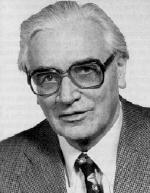Konrad Zuse
Engineer and inventor, b. 22 June 1910 (Berlin, Germany), d. 18 December 1995 (Hünfeld).
 Konrad Zuse was born in Berlin but spent his early years in Hoyerswerda, Saxony. As a young student he could not make up his mind what to study and fluctuated between engineering and painting. He used his painting skills to support himself at university but enrolled eventually in civil engineering and received his degree in 1935. In the following year he joined the Henschel Flugzeugwerke (Henschel Aviation Company) in Berlin.
Konrad Zuse was born in Berlin but spent his early years in Hoyerswerda, Saxony. As a young student he could not make up his mind what to study and fluctuated between engineering and painting. He used his painting skills to support himself at university but enrolled eventually in civil engineering and received his degree in 1935. In the following year he joined the Henschel Flugzeugwerke (Henschel Aviation Company) in Berlin.
Zuse did not like the lengthy calculations an engineer was required to perform and began to think about a computing machine in 1934. Between 1936 and 1938 he constructed the Z1, a programmable mechanical computer based on binary arithmetic and mechanical memory (which he had patented in 1936), in his parents' living room. Dissatisfied with some aspects of the Z1 he used second hand phone switching relays to build his second machine, the Z2.
During 1939 - 1941 Zuse built the Z3, helped by friends and a small government grant. It was the first reliable, freely programmable, working computer based on a binary floating-point number and switching system in the world.
In 1940 Zuse founded the Zuse Apparatebau, a computer manufacturing company. The company completed the development of the Z4, a model for series production based on the patented and reliable technology of the Z1, in 1945 but was bombed out before production could begin. The Z4 prototype was transported to Göttingen with the plan to have it stored in the nearby underground factories for the German rockets. When Zuse inspected the factories and discovered twenty thousand concentration camp prisoners working under unimaginable conditions in kilometre-long tunnels he refused, and the Z4 ended up in Oberjoch in the Bavarian Alps, the retreat of Wernher von Braun and his rocket design team. Zuse was adamant not to get involved in the rocket program and moved some 20 km away to Hinterstein, where he survived the years 1945 - 1947 by selling woodcuts to the local population and American soldiers.
In1948 Zuse managed to reassemble the Z4 in a former flour store, but electrical power was only available for a few hours each day and generally not sufficient to accommodate the Z4Ős power consumption.
At the same time the Eidgenössische Technische Hochschule (Federal Technical College) in Zürich, Switzerland, was looking into the possibility of building a computer and somehow got information about the Z4. Although it was based on outdated technology at the time (mechanical instead of electronic memory) it was the by far easiest machine to program, which was important if it was to be used by scientists for their work. The Z4 was transferred to Zürich and put to work.
Later in 1948 representatives of IBM approached Zuse with the aim to acquire his patents but gave no guarantee othat the Z4 would have a future at IBM. Zuse therefore started a new company, the Zuse KG. It began in 1949 with five employees and grew to about 1200 employees in 1964. By 1969 it had sold about 250 computers. Lack of capital led to a gradual takeover by Siemens. Today what remains of the Zuse tradition is part of Fujitsu-Siemens computers.
Being retired, Zuse rebuilt the Z1 between 1987 and 1989 for the Deutsches Technik Museum in Berlin. He had already rebuilt the Z3 in 1960 - 1961 during his time as company director. The rebuilt Z3 and the original Z4 are today on display in the Deutsches Museum in München.

The Z1 computer. In the foreground on top of the machine is the manual crank for driving the clock frequency by hand.
Reference
Zuse, H. (2004) The Life and Work of Konrad Zuse. EPE Online, http://www.epemag.com/zuse/ (accessed 8 September 2004
home
 Konrad Zuse was born in Berlin but spent his early years in Hoyerswerda, Saxony. As a young student he could not make up his mind what to study and fluctuated between engineering and painting. He used his painting skills to support himself at university but enrolled eventually in civil engineering and received his degree in 1935. In the following year he joined the Henschel Flugzeugwerke (Henschel Aviation Company) in Berlin.
Konrad Zuse was born in Berlin but spent his early years in Hoyerswerda, Saxony. As a young student he could not make up his mind what to study and fluctuated between engineering and painting. He used his painting skills to support himself at university but enrolled eventually in civil engineering and received his degree in 1935. In the following year he joined the Henschel Flugzeugwerke (Henschel Aviation Company) in Berlin.